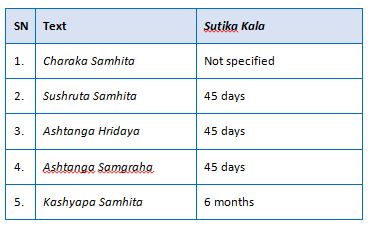Scientific applicability in day-to-day practice on Granthokta Sutika Paricharya
DOI:
https://doi.org/10.21760/jaims.8.12.18Keywords:
Sutika, Sutika Kala, Sutika Paricharya, postnatal periodAbstract
Being a mother is most challenging and most rewarding position a woman ever holds, so motherhood is wonderful at the same time its hardest phase for woman. Giving birth to a new life is a beautiful moment a women will cherish forever. But after the delivery, mothers body encounters many physical and psychological changes which may lead to the generalized weakness and backache etc., if proper postnatal care is not taken. Mother needs to recover and heal from the physical and emotional distress experienced during the delivery. So, proper care in postnatal period is essential. Ayurveda classics emphasize on both prenatal and postnatal care of the mother. There is detailed description of postnatal period and care known as Sutika Kala and Paricharaya respectively. After the childbirth when placenta is expelled out then women is termed as Sutika[1] and Paricharya means following the diet, regimen and medicines (Aahara, Vihara and Aushadha) during the Sutika Kala (postnatal period). According to Acharyas, Mithyaachrana during Sutika Kala may result in incurable disease, so extreme care must be taken during this period.[2] The main prospective of the Sutika Paricharya is to retrieve the strength and vitality of the mother’s body same as non-pregnant state along with stabilization of the physiological and psychological health. It also improves the quality and quantity of breast milk of mother. In present time due to changing lifestyles and food habits Sutika Paricharya can be a solution to many problems faced due to Mithyaachrana during the Sutika Kala.
Downloads
References
Hemaraj Sharma. Kashyapa Samhita Sanskrit introduction. Chaukhambha Sanskrit Sansthan, Varanasi; 10th edition, 2005; pg-305.
Atridev Gupta. Asthanga Sangraha of Vagbhata, edited. Krishnadas Academy, Varanasi; Vol 1 reprinted, edi-2005; pg-288.
Bramhananda Tripati. Charaka Samhita of Agnivesha. Chaukambha Surbharati Prakashana, Varanasi, 2013; Vol 1; pg 952.
Satyapala Bhigacharya. Kashyapa Samhita Of Vriddha Jeevaka. Chaukhambha Sanskrit Sansthan, Varanasi; edition-1994; Khilasthana chapter 10, 4th edition; pg-181.
Yadavaji Trikamaji. Charaka Samhita of Agnivesha, revised. Chaukhambha Orientalia, 5th edition, 2001; pg-348.
Yadavaji Trikamaji. Sushruta Samhita of Sushruta. Chaukhambha Orientalia, 8th edition, 2005; pg-389.
Kashinath Shastri. Asthanga Sangraha Of Vagbhata. Chaukhambha Orientalia, 9th edition, 2005; pg-376.
P.V.Tiwari. Ayurvediya Prasutitantra & Streeroga, Prasutitantra First-Part. Chaukhambha Sanskrit Samsthan, 2003; pg-549.
Hemaraj Sharma. Kashyapa Samhita. Chaukhambha Sanskrit Sansthan, 10th edition, 2005; pg-306.
Acharya Ramavalamba Shastri. Harita Samhita with Nirmala Hindi Commentary. Prachya prakashana, Varanasi, 1985; 1st edition; pg-104.
Hemaraj Sharma. Kashyapa Samhita. Chaukhambha Sanskrit Sansthan, 10th edition, 2005; pg-307.
All Things Healing. Ayurveda Massage and Postnatal care. Available from: http://www.allthingshealing.com/MartialArts/Abhyanga-Ayurveda_Massage-and-Postnatal-care/12173#
Yadavji Trikamji. Susruta Samhita. Chaukhambha Orientalia; 5th edition, 1992; pg-389.
Ayurveda. Udaravestana-www.ayurvedalive.in>post-delivery mother care for 1st week- Ayurveda [Accessed: [Date]].
Yadavji Trikamji. Susruta Samhita of Sushruta. Chaukhambha Orientalia; 5th edition, 1992; pg-18.
Misra Brahmasankara, Vaisya Rupalalaji. Bhavaprakasha Samhita. Chaukhambha Sanskrit Sansthan; 8th edition, 1993; Haritakyadivarga 72; pg-24.
Wikipedia. Milk. 2013. Available from: http://En.Wikipedia.Org/Wiki/Milk/;2013 27
Hemaraj Sharma. Kashyapa Samhita. Chaukambha Sanskrit Samsthan, 10th edition, 2005; pg 250.
Pandit Parusharam Shastri Vidyasagar. Sharangadhara Samhita. Chaukhambha Orientalia, 2005; pg-165.
Kumar A, Panghal S, Mallapur SS, Kumar M, Veerma Ram, Singh BK. Anti-inflammatory activity of Piper longum. Indian J Pharm Sci. 2009;71(4):pg-454-456.
Srinivasa Reddy P, Kaiser Jamil, Madhusudhan P, Anjali G, Das B. Antibacterial activity of isolates from Piper longum and Taxus baccata. Am J Eng Res. 2001;39(3):236-238.
Sharma PV. Dravyagunavijnana. Chaukhambha Bharati Academy; 16th edition, Varanasi, 1999; p. 278.
All Things Healing. An online community for healing mind, body, spirit, planet. Available from: http://www.allthingshealing.com
Poonam P. Khot, Amit L. Tamadaddi. Review Of Sutika Paricharya & Its Clinical Importance. Int Ayurvedic Med J [online]. 2017 [cited July, 2017].














